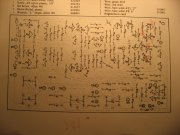62vauxhall
Veteran and General Yakker
- Joined
- May 14, 2014
- Messages
- 2,358
- Location
- Southwest Kootenays BC
- Tagline
- No such things as bad days, just bad moments
Within the past week I decided to use a (built by someone from a kit) Hafler DH101 preamp that's been more or less idle for some time. I've had it well over ten years and during that time have replaced all the electrolytic capacitors, RCA jacks and the strips the jacks mount to. The times I did use it, other than it's inherent quirks, it seemed to function OK.
My last go at using it, I heard a previously unnoticed background noise which I've determined to be heat caused. The pre-amp was sitting on top of a MOSFET power amp. The noise did not manifest until things warmed up. Fairly sure the noise is transistor related because I blew hot air over the PC board and soon, the noise appeared.
The method was crude and I could not tell which transistor or transistors were to blame. There aren't many transistor types present so I began trying to learn which new transistors could replace what originals are on the board.
Over the past couple of days, I read posts in online forums about Hafler DH101 repairs or restorations. I compiled a list of candidate transistors but am puzzled about some HFE numbers.
Some existing Darlington transistors on the board are MPSA63 (or MPSA65) with an HFE of 20 & 50 respectfully. If I understood correctly, a BC516 can replace it but it's HFE is 30,000.
The companion MPSA13 has HFE of 5. Suggested replacement for that one is BSC517 with HFA of also 30,000.
That is a big disparity between values.
I've already ordered BC516 & BC517 but am now wondering about those substantially higher HFE values.
My last go at using it, I heard a previously unnoticed background noise which I've determined to be heat caused. The pre-amp was sitting on top of a MOSFET power amp. The noise did not manifest until things warmed up. Fairly sure the noise is transistor related because I blew hot air over the PC board and soon, the noise appeared.
The method was crude and I could not tell which transistor or transistors were to blame. There aren't many transistor types present so I began trying to learn which new transistors could replace what originals are on the board.
Over the past couple of days, I read posts in online forums about Hafler DH101 repairs or restorations. I compiled a list of candidate transistors but am puzzled about some HFE numbers.
Some existing Darlington transistors on the board are MPSA63 (or MPSA65) with an HFE of 20 & 50 respectfully. If I understood correctly, a BC516 can replace it but it's HFE is 30,000.
The companion MPSA13 has HFE of 5. Suggested replacement for that one is BSC517 with HFA of also 30,000.
That is a big disparity between values.
I've already ordered BC516 & BC517 but am now wondering about those substantially higher HFE values.

